Select materials
by and about
Martin Luther King, Jr.
- MLK:
His place in the history of the modern civil
rights movement (1)
- MLK:
His place in the history of the modern civil
rights movement (2)
- MLK
and the Montgomery Bus Boycott
- Montogomery
Bus Boycott
- The
March on Washington "I have a Dream" Speech
- MLK:
Philosophy and Strategy of Nonviolent Resistance
- MLK:
Visit to India
- Martin
Luther King, Jr. Papers Project
- Martin
Luther King, Jr., National Historic Site's Online
Visitor Information Center
- Book:Stride Toward
Freedom: The Montgomery Story. New
York: Harper & Row, 1958.
- Book: Where Do
We Go from Here: Chaos or Community? Boston:
Beacon Press, 1968.
- Book: Baldwin,
Lewis V. Toward the Beloved Community: Martin
Luther King, Jr. and South Africa. Cleveland:
Pilgrim Press, 1995.
|
Martin Luther
King, Jr.
(15 January
1929-4 April 1968)
Martin
Luther King, Jr., made history, but he was also
transformed by his deep family roots in the
African-American Baptist church, his formative
experiences in his hometown of Atlanta, his
theological studies, his varied models of religious
and political leadership, and his extensive network
of contacts in the peace and social justice
movements of his time. Although King was only
thirty-nine at the time of his death, his life was
remarkable for the ways it reflected and inspired so
many of the twentieth century’s major intellectual,
cultural, and political developments.
The son, grandson, and great-grandson of Baptist
ministers, Martin Luther King Jr., named Michael
King at birth, was born in Atlanta and
spent his first twelve years in the Auburn Avenue
home that his parents, the Reverend Michael King and
Alberta Williams King, shared with his maternal
grandparents, the Reverend Adam Daniel (A. D.)
Williams and Jeannie Celeste Williams. After Rev.
Williams’ death in 1931, his son-in-law became
Ebenezer Baptist Church’s new pastor and gradually
established himself as a major figure in state and
national Baptist groups. The elder King began
referring to himself (and later to his son) as
Martin Luther King.
King’s formative experiences not only immersed him
in the affairs of Ebenezer but also introduced him
to the African-American social gospel tradition
exemplified by his father and grandfather, both of
whom were leaders of the Atlanta branch of the
National Association for the Advancement of Colored
People (NAACP).
Depression-era breadlines heightened King’s
awareness of economic inequities, and his father’s
leadership of campaigns against racial
discrimination in voting and teachers’ salaries
provided a model for the younger King’s own
politically engaged ministry. He resisted religious
emotionalism and as a teenager questioned some
facets of Baptist doctrine, such as the bodily
resurrection of Jesus.
During his undergraduate years at Atlanta’s
Morehouse College from 1944 to 1948, King gradually
overcame his initial reluctance to accept his
inherited calling. Morehouse president Benjamin E.
Mays influenced King’s spiritual development,
encouraging him to view Christianity as a potential
force for progressive social change. Religion
professor George Kelsey exposed him to biblical
criticism and, according to King’s autobiographical sketch,
taught him “that behind the legends and myths of the
Book were many profound truths which one could not
escape” (Papers 1:43). King admired both educators
as deeply religious yet also learned men and by the
end of his junior year, such academic role models
and the example of his father led King to enter the
ministry. He described his decision as a response to
an “inner urge” calling him to “serve humanity”
(Papers 1:363). He was ordained during his final
semester at Morehouse, and by this time King had
also taken his first steps toward political
activism. He had responded to the postwar wave of
anti-black violence by proclaiming in a letter to
the editor of the Atlanta Constitution that African
Americans were “entitled to the basic rights and
opportunities of American citizens” (Papers
1:121). During his senior year King joined the
Intercollegiate Council, an interracial student
discussion group that met monthly at Atlanta’s Emory
University.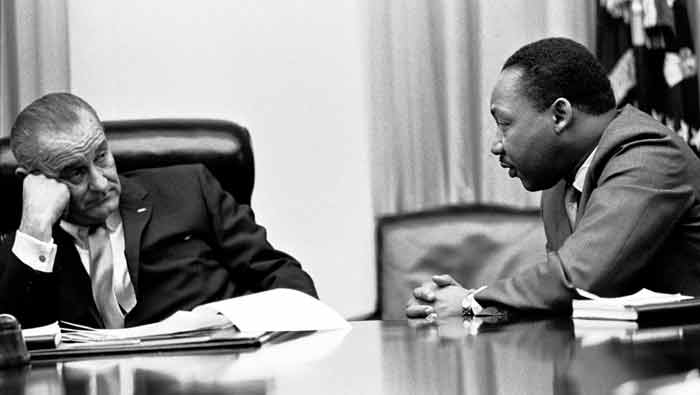
MLK with President Lyndon B.
Johnson
After
leaving Morehouse, King increased his understanding
of liberal Christian thought while attending Crozer
Theological Seminary in Pennsylvania from 1948 to
1951. Initially uncritical of liberal theology, he
gradually moved toward Reinhold Niebuhr’s
neoorthodoxy, which emphasized the intractability of
social evil. Mentored by local minister, J. Pius
Barbour, he reacted skeptically to a presentation on
pacifism by Fellowship of Reconciliation leader A.
J. Muste. Moreover, by the end of his seminary
studies King had become increasingly dissatisfied
with the abstract conceptions of God held by some
modern theologians and identified himself instead
with the theologians who affirmed personalism, or a
belief in the personality of God. Even as he
continued to question and modify his own religious
beliefs, he complied an outstanding academic record
and graduated at the top of his class.
In 1951 King began doctoral studies in systematic
theology at Boston University’s School of Theology,
which was dominated by personalist theologians such
as Edgar Brightman and L. Harold DeWolf. The papers
(including his dissertation) that King wrote during
his years at Boston displayed little originality,
and some contained extensive plagiarism; but his
readings enabled him to formulate an eclectic yet
coherent theological perspective. By the time he
completed his doctoral studies in 1955, King had
refined his exceptional ability to draw upon a wide
range of theological and philosophical texts to
express his views with force and precision. His
ability to infuse his oratory with borrowed
theological insights became evident in his expanding
preaching activities in Boston-area-churches and at
Ebenezer, where he assisted his father during school
vacations.
During his stay in Boston, King also met and courted
Coretta
Scott, an Alabama-born Antioch College
graduate who was then a student at the New England
Conservatory of Music. On 18 June 1953 the two
students were married in Marion, Alabama, where
Scott’s family lived.
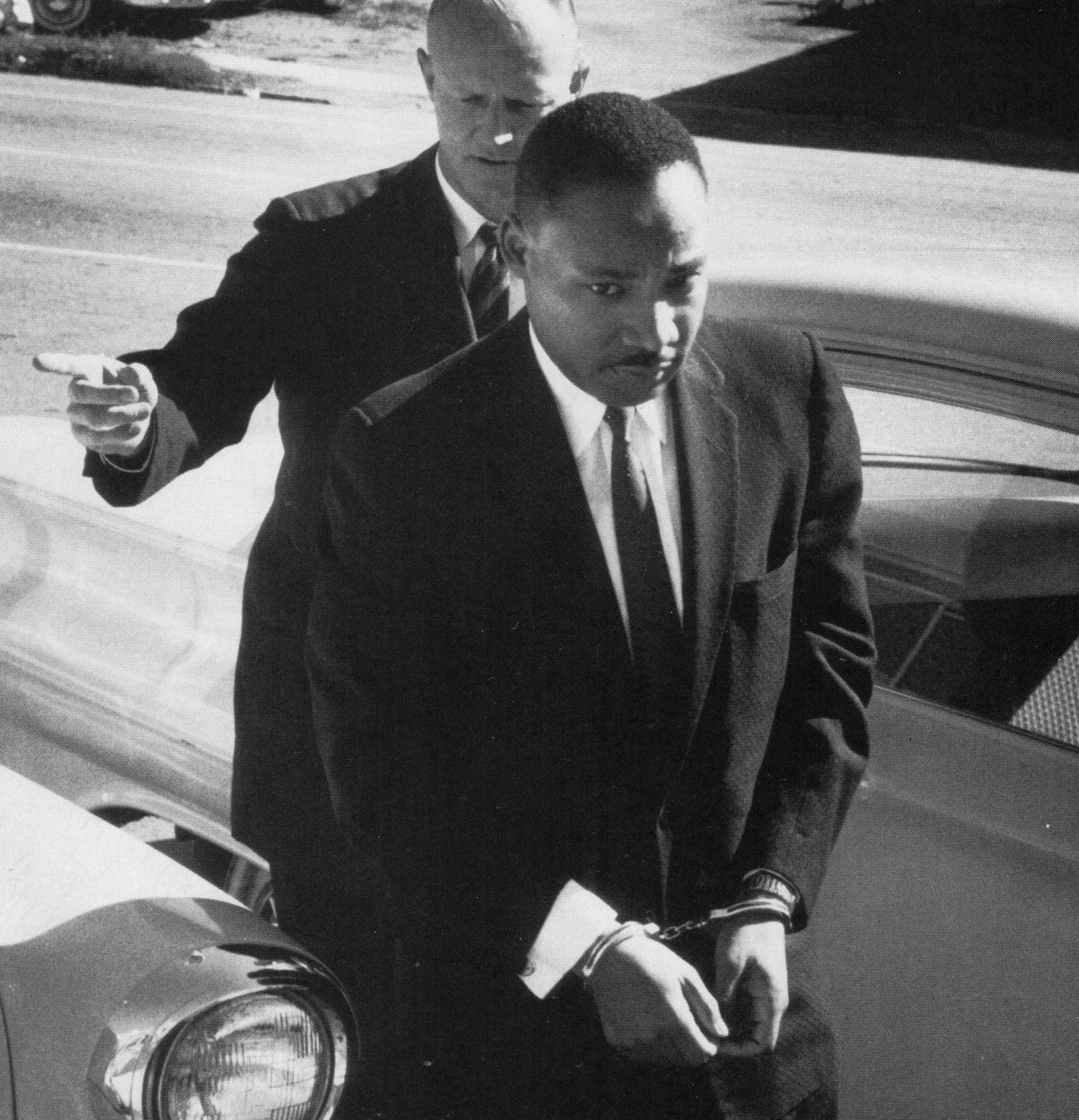
Although he considered pursuing an academic career,
King decided in 1954 to accept an offer to become
the pastor of Dexter Avenue Baptist Church in
Montgomery, Alabama. In December 1955, when
Montgomery black leaders, such as Jo Ann Robinson,
E. D. Nixon, and Ralph Abernathy formed the
Montgomery Improvement Association (MIA) to protest
the arrest of NAACP official Rosa
Parks for refusing to give up her bus seat to
a white man, they selected King to head the new
group. In his role as the primary spokesman of the
year-long Montgomery
bus boycott, King utilized the leadership
abilities he had gained from his religious
background and academic training to forge a
distinctive protest strategy that involved the
mobilization of black churches and skillful appeals
for white support. With the encouragement of Bayard
Rustin, Glenn Smiley, William Stuart Nelson and
other veteran pacifists, King also became a firm
advocate of Mohandas
[Mahatma] Gandhi’s precepts of nonviolence,
which he combined with Christian social gospel
ideas.
After the United States Supreme Court
outlawed Alabama bus segregation laws in Browder v.
Gayle in late 1956, King sought to expand the
nonviolent civil rights movement throughout the
South. In 1957 he joined with C. K. Steele, Fred
Shuttlesworth and T .J. Jemison in founding the
Southern Christian Leadership Conference (SCLC)
with King as president to coordinate civil rights
activities throughout the region. Publication of
Stride Toward Freedom: The Montgomery Story (1958)
further contributed to King’s rapid emergence as a
national civil rights leader. Even as he expanded
his influence, however, King acted cautiously.
Rather than immediately seeking to stimulate mass
desegregation protests in the South, King stressed
the goal of achieving black voting rights when he
addressed an audience at the 1957 Prayer Pilgrimage
for Freedom.
King’s rise to fame was not without personal
consequences. In 1958 King was the victim of his
first assassination attempt. Although his house had
been bombed several times during the Montgomery bus
boycott, it was while signing copies of Stride
Toward Freedom that Izola Ware Curry stabbed him
with a letter opener. Surgery to remove it was
successful, but King had to recuperate for several
months, giving up all protest activity.
One of the key aspects of King’s leadership was his
ability to establish support from many types of
organizations including labor unions, peace
organizations, southern reform organizations, and
religious groups. As early as 1956, labor unions,
such as the United Packinghouse Workers and the
United Auto Workers contributed to the MIA and peace
activists such as Homer Jack alerted their
associates to the activities of the MIA. Activists
from southern organizations such as Myles Horton’s
Highlander Folk School and Anne Braden’s Southern
Conference Education Fund were in frequent contact
with King. In addition, his extensive ties to the
National Baptist Convention provided support from
churches all over the nation; and his advisor,
Stanley Levison insured broad support from Jewish
groups.
King’s recognition of the link between segregation
and colonialism resulted in alliances with groups
fighting oppression outside the U.S., especially in
Africa. In March 1957, King traveled to Ghana at the
invitation of Kwame Nkrumah to attend the nation’s
independence ceremony. Shortly after returning from
Ghana King joined the American Committee on Africa
agreeing to serve as vice chair
man of an
International Sponsoring Committee for a day of
protest against South Africa’s apartheid government.
Later at a SCLC sponsored event honoring Kenyan
labor leader Tom Mboya, King further articulated the
connections between the African-American freedom
struggle and those abroad: “We are all caught in an
inescapable network of mutuality” (Papers 5:204).
During 1959 he increased his understanding of
Gandhian ideas during a month-long visit to India
sponsored by the American
Friends Service Committee. With Coretta and
MIA historian Lawrence D. Reddick in tow, King meet
with many Indian leaders, including Prime Minister Jawaharlal
Nehru. Writing after his return, King stated,
“I left India more convinced than ever before that
non-violent resistance is the most potent weapon
available to oppressed people in their struggle for
freedom” (Papers 5:233).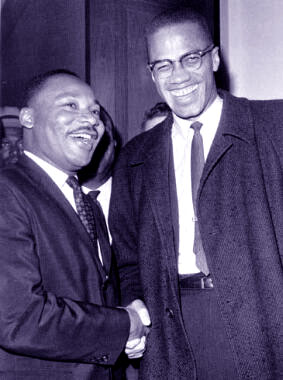
MLK with Malcolm X
Early the
following year he moved his family, which now
included two children,Yolanda and Martin Luther
King, III, to Atlanta in order to be nearer SCLC
headquarters in that city and to become co-pastor,
with his father, of Ebenezer Baptist Church. (The
Kings’ third child, Dexter, was born in 1961; their
fourth, Bernice, was born in 1963.) Soon after
King’s arrival in Atlanta, the southern civil rights
movement gained new impetus from the student-led
lunch counter sit-in movement that spread throughout
the region during 1960. The sit-ins brought into
existence a new protest group, the Student
Nonviolent Coordinating Committee (SNCC),
which would often push King toward greater
militancy. King came in contact with students,
especially those from Nashville such as John Lewis,
James Bevel and Diane Nash who had been trained in
nonviolent tactics by James Lawson. In October 1960
King’s arrest during a student-initiated protest in
Atlanta became an issue in the national presidential
campaign when Democratic candidate John F. Kennedy
called Coretta King to express his concern. The
successful efforts of Kennedy supporters to secure
King’s release contributed to the Democratic
candidate’s narrow victory over Republican candidate
Richard Nixon.
King’s
decision to move to Atlanta was partly caused by
SCLC’s lack of success during the late 1950s.
Associate director Ella Baker had complained that
the SCLC’s Crusade for Citizenship suffered from
lack of attention from King. SCLC leaders hoped that
with King now in Atlanta, programming would be
improved. The hiring of Wyatt T. Walker as executive
director in 1960 was also seen as a step toward
bringing efficiency to the organization, while the
addition of Dorothy Cotton and Andrew Young to the
staff infused new leadership after SCLC took over
the administration of the Citizenship Education
program pioneered by Septima Clark. Attorney
Clarence Jones also began to assist King and SCLC
with legal matters and to act as King’s advisor.
As the southern protest movement expanded during the
early 1960s, King was often torn between the
increasingly militant student activists, such as
those who participated in the Freedom
Rides and more cautious national civil rights
leaders. During 1961 and 1962 his tactical
differences with SNCC activists surfaced during a
sustained protest movement in Albany, Georgia. King
was arrested twice during demonstrations organized
by the Albany Movement, but when he left jail and
ultimately left Albany without achieving a victory,
some movement activists began to question his
militancy and his dominant role within the southern
protest movement.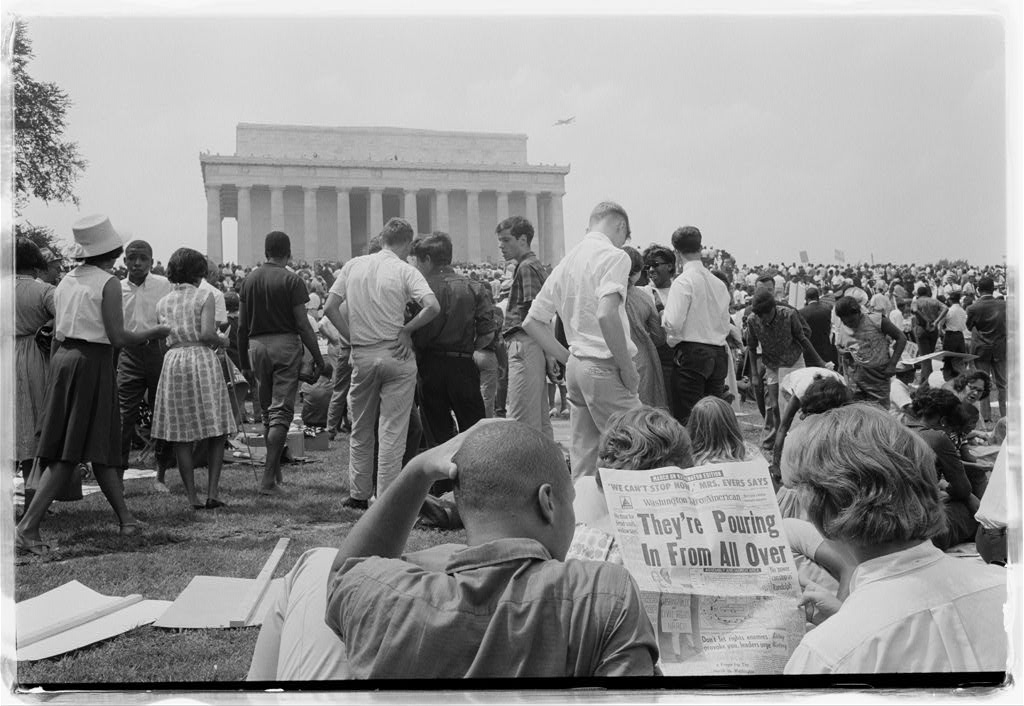
As King encountered increasingly fierce white
opposition, he continued his movement away from
theological abstractions toward more reassuring
conceptions, rooted in African-American religious
culture, of God as a constant source of support. He
later wrote in his book of sermons, Strength to Love
(1963), that the travails of movement leadership
caused him to abandon the notion of God as
“theological and philosophically satisfying” and
caused him to view God as “a living reality that has
been validated in the experiences of everyday life”
(Papers 5:424).
During
1963, however, King reasserted his preeminence
within the African-American freedom struggle through
his leadership of the Birmingham
campaign. Initiated by SCLC and its affiliate,
the Alabama Christian Movement for Human Rights, the
Birmingham demonstrations were the most massive
civil rights protest that had yet occurred. With the
assistance of Fred Shuttlesworth and other local
black leaders and with little competition from SNCC
and other civil rights groups, SCLC officials were
able to orchestrate the Birmingham protests to
achieve maximum national impact. King’s decision to
intentionally allow himself to be arrested for
leading a demonstration on 12 April prodded the
Kennedy administration to intervene in the
escalating protests. A widely quoted “Letter from
Birmingham Jail” displayed his distinctive ability
to influence public opinion by appropriating ideas
from the Bible, the Constitution, and other
canonical texts. During May, televised pictures of
police using dogs and fire hoses against young
demonstrators generated a national outcry against
white segregationist officials in Birmingham. The
brutality of Birmingham officials and the refusal of
Alabama governor George C. Wallace to allow the
admission of black students at the University of
Alabama prompted President Kennedy to introduce
major civil rights legislation.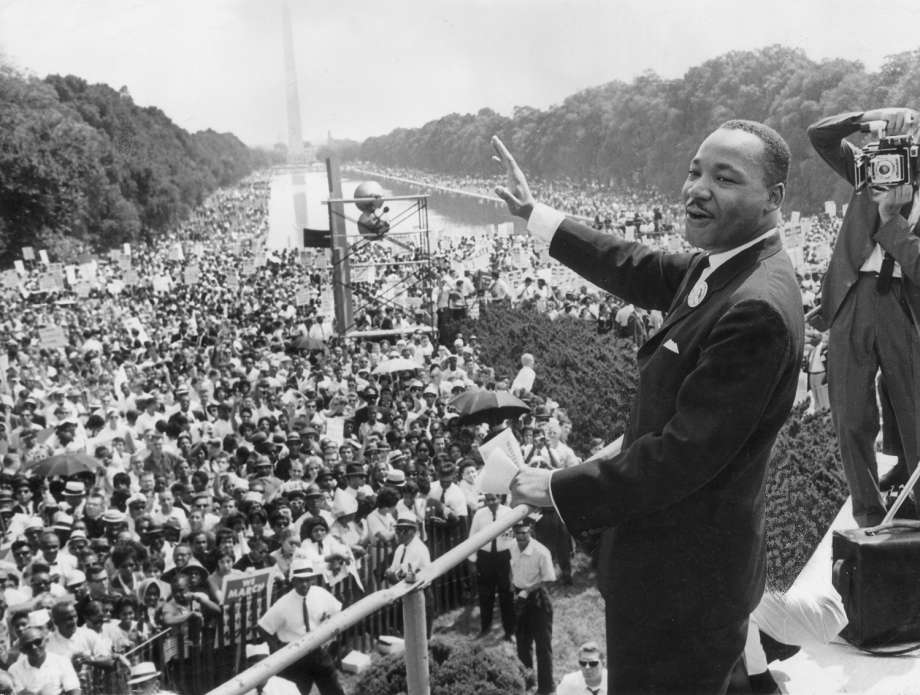
King’s
speech at the 28 August 1963 March
on Washington for Jobs and Freedom attended by
more than 200,000 people, was the culmination of a
wave of civil rights protest activity that extended
even to northern cities. In his prepared remarks
King announced that African Americans wished to cash
the “promissory note” signified in the egalitarian
rhetoric of the Constitution and the Declaration of
Independence. Closing his address with
extemporaneous remarks, he insisted that he had not
lost hope: “I say to you today, my friends, so even
though we face the difficulties of today and
tomorrow, I still have a dream. It is a dream deeply
rooted in the American dream . . . that one
day this nation will rise up and live out the true
meaning of its creed:‘we hold these truths to be
self-evident, that all men are created equal.’” He
appropriated the familiar words of “My Country ‘Tis
of Thee” before concluding, “when we allow freedom
ring, when we let it ring from every village and
every hamlet, from every state and every city, we
will be able to speed up that day when all of God’s
children, black men and white men, Jews and
Gentiles, Protestants and Catholics, will be able to
join hands and sing in the words of the old Negro
spiritual, ‘Free at last, free at last, thank God
Almighty, we are free at last’” (King, Call, 82, 85,
87).
Although there was much elation after the March on
Washington, less than a month later, the movement
was shocked by another act of senseless violence. On
15 September 1963 a dynamite blast killed four young
school girls at Birmingham’s Sixteenth Street
Baptist Church. King delivered the eulogy for three
of the four girls, reflecting, “They say to us that
we must be concerned not merely about who murdered
them, but about the system, the way of life, and the
philosophy which produced the murders” (King, Call,
96).
St. Augustine, Florida became the site of the next
major confrontation of the civil rights movement.
Beginning in 1963 Robert B. Hayling, of the local
NAACP had led sit-ins against segregated businesses.
SCLC was called in to help in May 1964, suffering
the arrest of King and Abernathy. After a few court
victories, SCLC left when a bi-racial committee was
formed; however, local residents continued to suffer
violence.
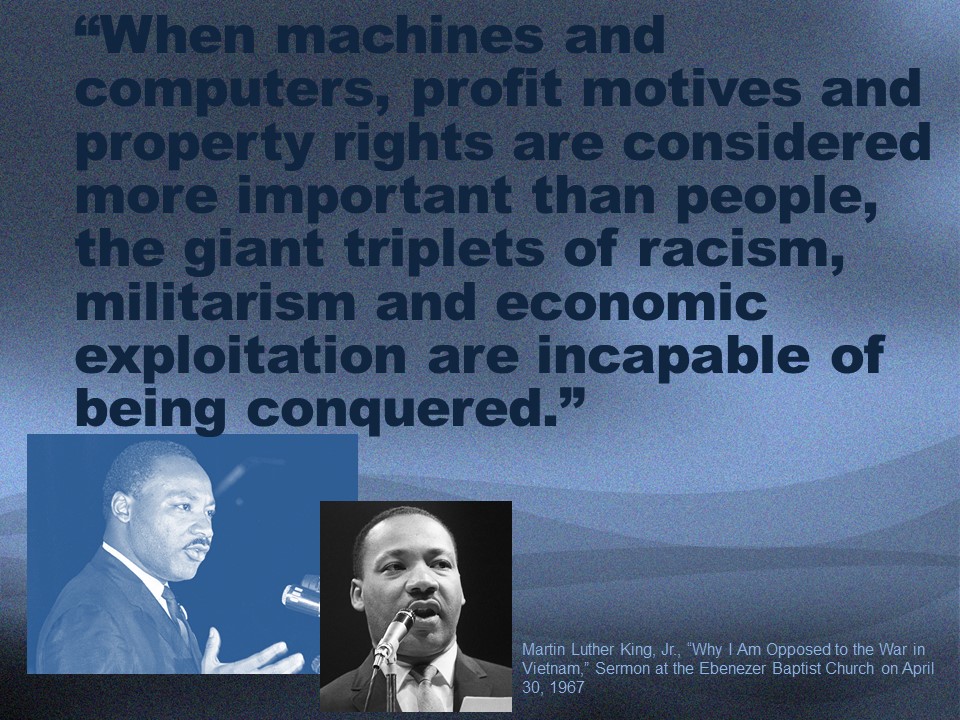
King’s
ability to focus national attention on orchestrated
confrontations with racist authorities, combined
with his oration at the 1963 March on Washington, made
him the most influential African-American
spokesperson of the first half of the 1960s. Named
Time magazine’s “Man of the Year” at the end of
1963, he was awarded the Nobel Peace Prize in
December 1964. The acclaim King received
strengthened his stature among civil rights leaders
but also prompted Federal Bureau of Investigation
director J. Edgar Hoover to step up his effort to
damage King’s reputation. Hoover, with the approval
of President Kennedy and Attorney General Robert
Kennedy, established phone taps and bugs. Hoover and
many other observers of the southern struggle saw
King as controlling events, but he was actually a
moderating force within an increasingly diverse
black militancy of the mid-1960s. Although he was
not personally involved in Freedom
Summer (1964), he was called upon to attempt
to persuade the Mississippi Freedom Democratic Party
delegates to accept a compromise at the Democratic
Party National Convention.
As the African-American struggle expanded from
desegregation protests to mass movements seeking
economic and political gains in the North as well as
the South, King’s active involvement was limited to
a few highly publicized civil rights campaigns, such
as Birmingham and St. Augustine, which secured
popular support for the passage of national civil
rights legislation, particularly the Civil Rights
Act of 1964.
The Alabama protests reached a turning point on 7
March when state police attacked a group of
demonstrators at the start of a march from Selma to
the state capitol in Montgomery. Carrying out
Governor Wallace’s orders, the police used tear gas
and clubs to turn back the marchers after they
crossed the Edmund Pettus Bridge on the outskirts of
Selma. Unprepared for the violent confrontation,
King alienated some activists when he decided to
postpone the continuation of the Selma
to Montgomery March until he had received
court approval, but the march, which finally secured
federal court approval, attracted several thousand
civil rights sympathizers, black and white, from all
regions of the nation. On 25 March King addressed
the arriving marchers from the steps of the capitol
in Montgomery. The march and the subsequent killing
of a white participant, Viola Liuzzo, as well as the
earlier murder of James Reeb dramatized the denial
of black voting rights and spurred passage during
the following summer of the Voting
Rights Act of 1965.
After the successful voting rights march in
Alabama, King was unable to garner similar support
for his effort to confront the problems of northern
urban blacks. Early in 1966 he, together with local
activist Al Raby, launched a major campaign against
poverty and other urban problems and moved his
family into an apartment in Chicago’s black ghetto.
As King shifted the focus of his activities to the
North, however, he discovered that the tactics used
in the South were not as effective elsewhere. He
encountered formidable opposition from Mayor Richard
Daley and was unable to mobilize Chicago’s
economically and ideologically diverse black
community. King was stoned by angry whites in the
Chicago suburb of Cicero when he led a march against
racial discrimination in housing. Despite numerous
mass protests, the Chicago Campaign resulted in no
significant gains and undermined King’s reputation
as an effective civil rights leader.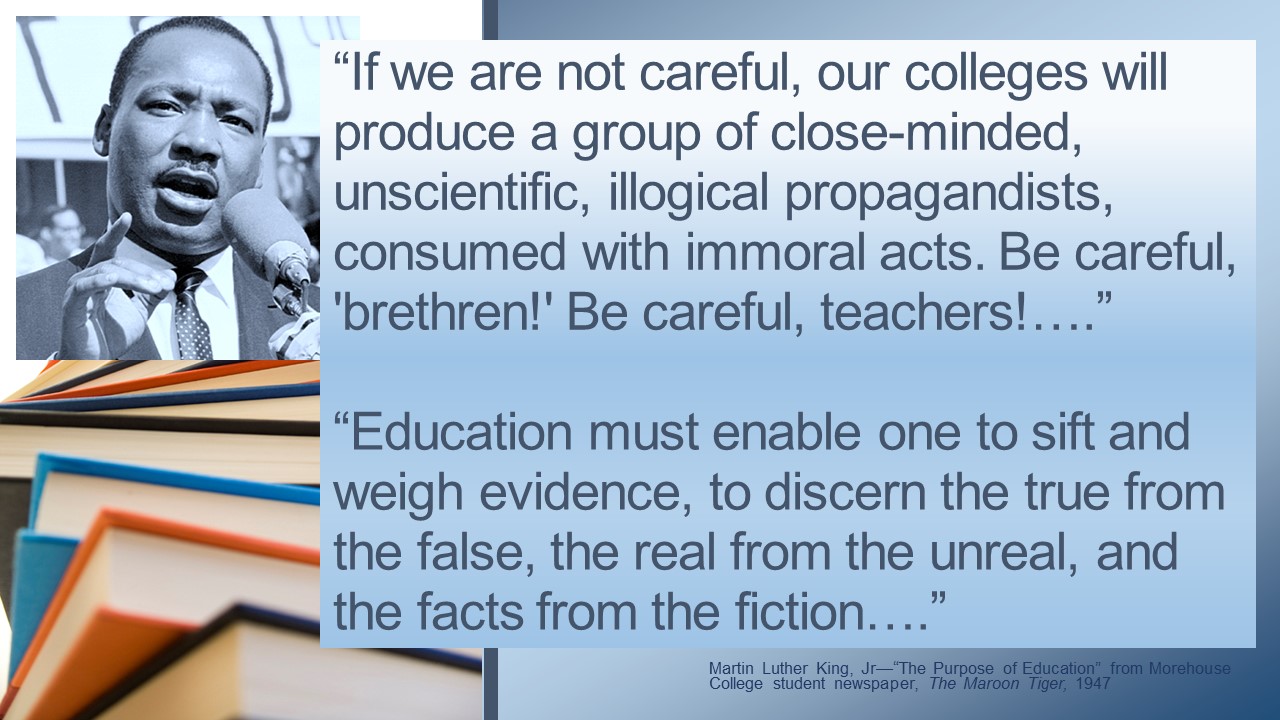
King’s influence was damaged further by the
increasingly caustic tone of black militancy of the
period after 1965. Black radicals increasingly
turned away from the Gandhian precepts of King
toward the Black Nationalism of Malcolm
X, whose posthumously published autobiography
and speeches reached large audiences after his
assassination in February 1965. Unable to influence
the black insurgencies that occurred in many urban
areas, King refused to abandon his firmly rooted
beliefs about racial integration and nonviolence. He
was nevertheless unpersuaded by black nationalist
calls for racial uplift and institutional
development in black communities.
In June 1966, James
Meredith was shot while attempting a “March
against Fear” in Mississippi. King, Floyd
McKissick of the Congress
of Racial Equality and Stokely
Carmichael of SNCC decided to continue his
march. During the march, the activists from SNCC
decided to test a new slogan that they had been
using, Black Power. King objected to the use of the
term, but the media took the opportunity to expose
the disagreements among protestors and publicized
the term.
In his last book, Where Do We Go from
Here: Chaos or Community? (1967), King
dismissed the claim of Black Power advocates “to be
the most revolutionary wing of the social revolution
taking place in the United States,” but he
acknowledged that they responded to a psychological
need among African Americans he had not previously
addressed (King, Where Do We Go, 45-46).
“Psychological freedom, a firm sense of self-esteem,
is the most powerful weapon against the long night
of physical slavery,” King wrote. “The Negro will
only be free when he reaches down to the inner
depths of his own being and signs with the pen and
ink of assertive manhood his own emancipation
proclamation” (King, Call, 184).
Indeed, even as his popularity declined, King spoke
out strongly against American involvement in the Vietnam
War, making his position public in an address,
“Beyond
Vietnam,” on 4 April 1967 at New York’s
Riverside Church. King’s involvement in the anti-war
movement reduced his ability to influence national
racial policies and made him a target of further FBI
investigations. Nevertheless, he became ever more
insistent that his version of Gandhian nonviolence
and social gospel Christianity was the most
appropriate response to the problems of black
Americans.
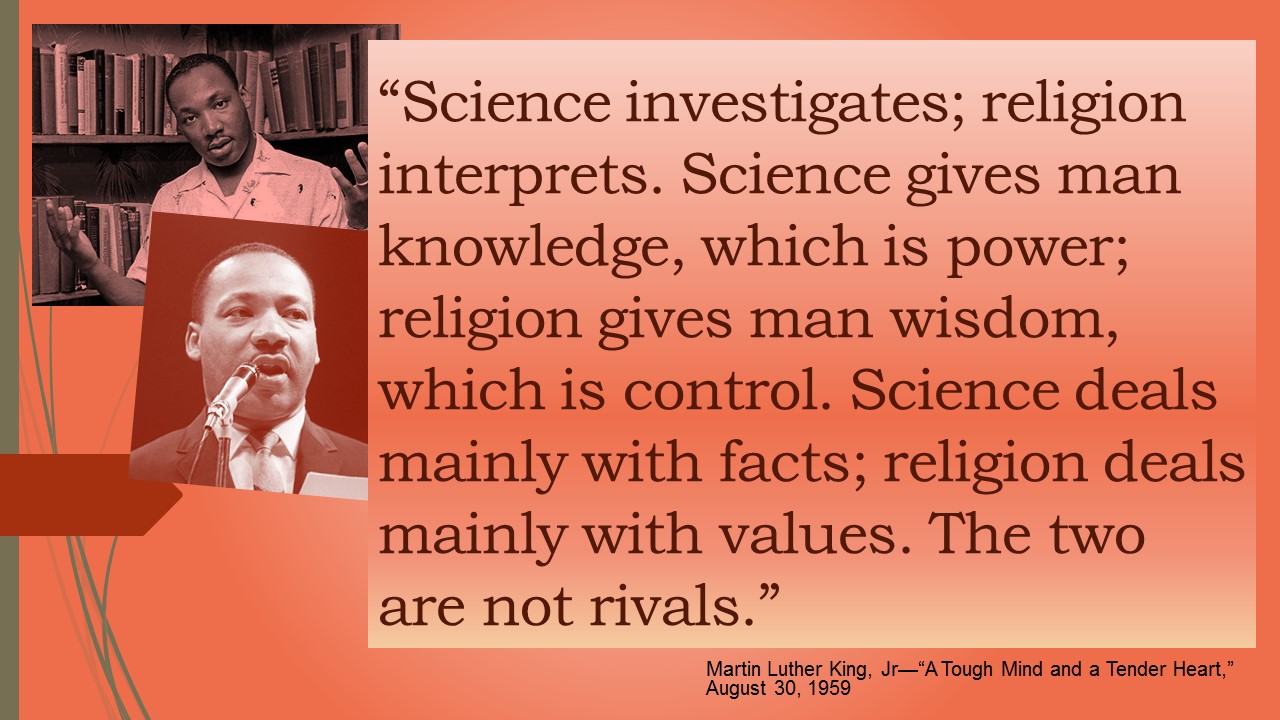
In December 1967 King announced the formation of the
Poor
People’s Campaign, designed to prod the
federal government to strengthen its antipoverty
efforts. King and other SCLC workers began to
recruit poor people and antipoverty activists to
come to Washington, D.C., to lobby on behalf of
improved antipoverty programs. This effort was in
its early stages when King became involved in the Memphis
sanitation workers’ strike in Tennessee. On 28
March 1968, as King led thousands of sanitation
workers and sympathizers on a march through downtown
Memphis, black youngsters began throwing rocks and
looting stores. This outbreak of violence led to
extensive press criticisms of King’s entire
antipoverty strategy. King returned to Memphis for
the last time in early April. Addressing an audience
at Bishop Charles J. Mason Temple on 3 April, King
affirmed his optimism despite the “difficult days”
that lay ahead. “But it really doesn’t matter with
me now,” he declared, “because I’ve been to the
mountaintop [and] I’ve seen the Promised Land.” He
continued, “I may not get there with you. But I want
you to know tonight, that we, as a people, will get
to the Promised Land.” (King, Call, 222-223). The
following evening the assassination
of Martin Luther King, Jr. took place as he
stood on a balcony of the Lorraine Motel in Memphis.
A white segregationist, James Earl Ray, was later
convicted of the crime. The Poor People’s Campaign
continued for a few months after his death under the
direction of Ralph Abernathy, the new SCLC
president, but it did not achieve its objectives.
Until his
death King remained steadfast in his commitment to
the radical transformation of American society
through nonviolent activism. In his posthumously
published essay, “A Testament of Hope” (1969), he
urged African Americans to refrain from violence but
also warned, “White America must recognize that
justice for black people cannot be achieved without
radical changes in the structure of our society.”
The “black revolution” was more than a civil rights
movement, he insisted. “It is forcing America to
face all its interrelated flaws-racism, poverty,
militarism and materialism” (King, “Testament,”
194).
After her husband’s death, Coretta Scott King
established the Atlanta-based Martin Luther King,
Jr., Center for Nonviolent Social Change (also known
as the King
Center) to promote Gandhian-Kingian concepts
of nonviolent struggle. She also led the successful
effort to honor her husband with a federally
mandated King national holiday, which was first
celebrated in 1986. 
Sources:
Introduction, in Papers 1:1-57.
King, “An Autobiography of Religious Development,”
12 September-22 November 1950, in Papers 1:359-363.
—, “Eulogy for the Young Victims of the Sixteenth
Street Baptist Church Bombing,” in A Call to
Conscience, eds. Clayborne Carson and Kris Shepard,
New York: Warner Books, 2001, pp. 95-99.
—, “I Have a Dream,” in A Call to Conscience, eds.
Clayborne Carson and Kris Shepard, New York: Warner
Books, 2001, pp. 81-87.
—, “I’ve Been to the Mountaintop,” in A Call to
Conscience, eds. Clayborne Carson and Kris Shepard,
New York: Warner Books, 2001, pp. 207-223.
—, “Kick Up Dust,” Letter to the Editor, Atlanta
Constitution, in Papers 1:121.
—, “My
Trip to the Land of Gandhi,” in Papers 5:231-238.
—, “Pilgrimage to Nonviolence,” in Papers 5:419-425.
—, Remarks Delivered at Africa Freedom Dinner at
Atlanta University, in Papers 5:203-204.
—, Strength to Love, 1963.
—, “A Testament of Hope,” in Playboy, 16 January
1969, pp. 193-194, 231-236.
—, “Where Do We Go From Here?” in A Call to
Conscience, eds. Clayborne Carson and Kris Shepard,
New York: Warner Books, 2001, pp. 171-199.
—, Where Do We Go From Here: Chaos or Community?,
Boston: Beacon Press, 1967.
SOURCE OF THE
TEXT OF THIS BIOGRAPHY:
http://kingencyclopedia.stanford.edu/encyclopedia/encyclopedia/enc_martin_luther_king_jr_biography/index.html
ALL IMAGES are
copyrighted by their respective owners.
|










